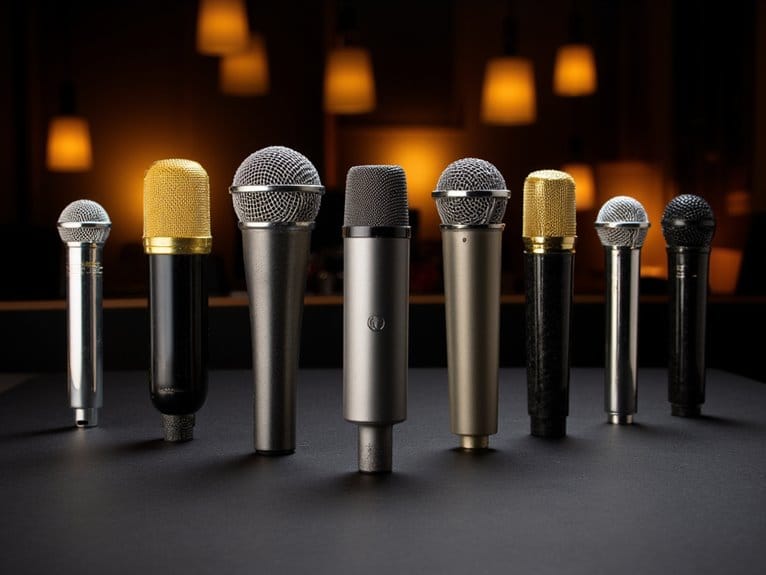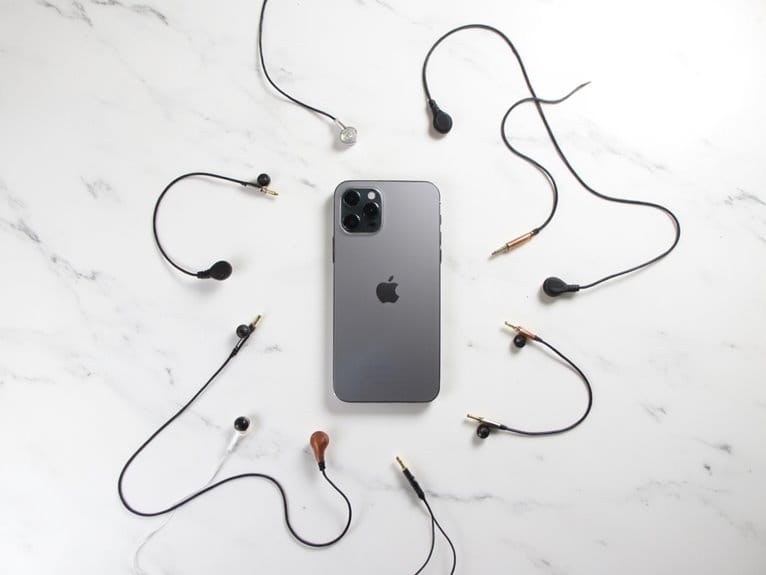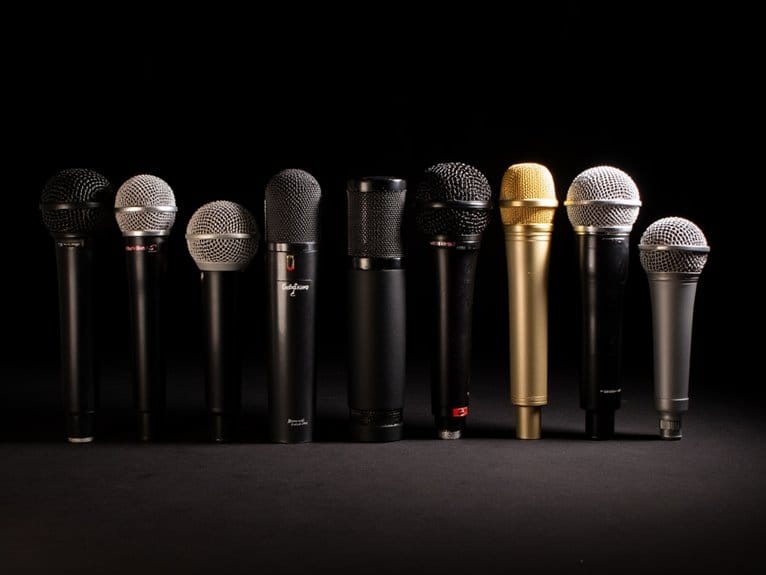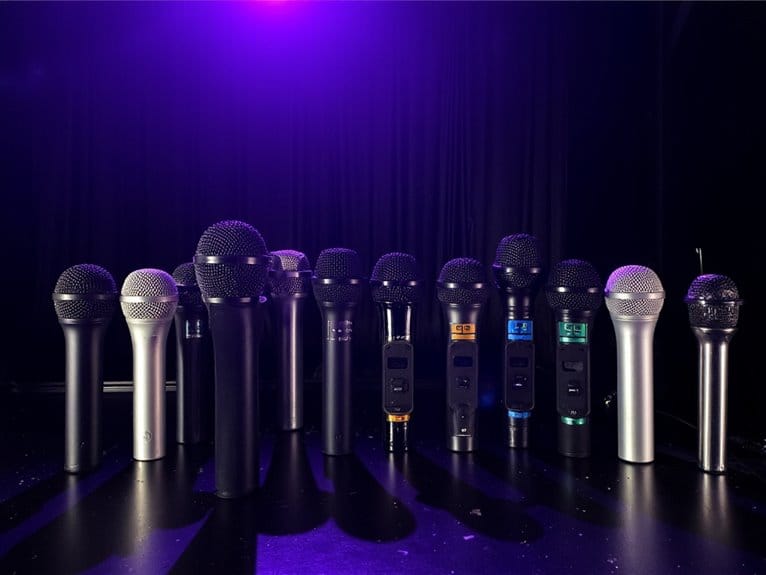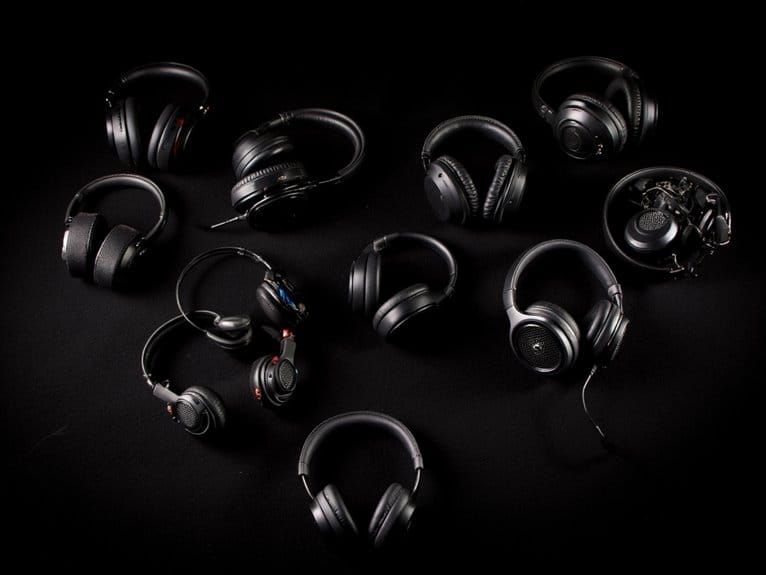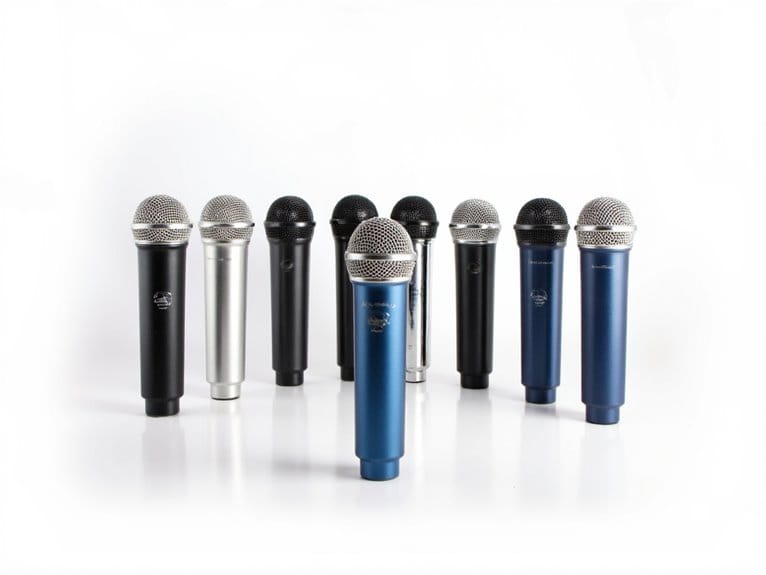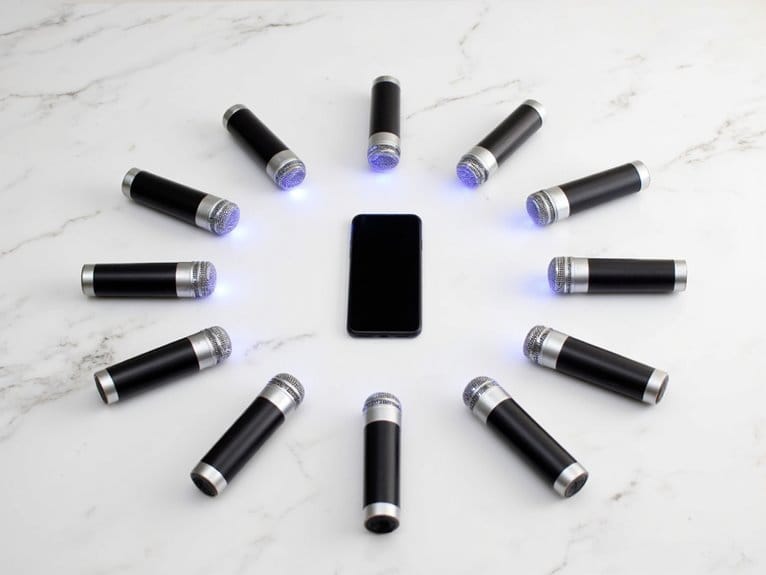10 Best Condenser Mics for Professional Audio Recording
After testing dozens of condenser microphones, I’ve found that the RØDE NT1 5th Generation consistently outperforms competitors with its exceptional 4 dB self-noise floor and dual XLR/USB connectivity, making it ideal for professional studios. The Audio-Technica AT2020 delivers extended frequency response perfect for home recording, while budget-conscious creators will appreciate the FIFINE K688’s dual connectivity and complete accessory package. Each model offers distinct advantages depending on your specific recording environment and connectivity preferences that I’ll explore further below.
We are supported by our audience. When you purchase through links on our site, we may earn an affiliate commission, at no extra cost for you. Learn more.
Notable Insights
- RØDE NT1 Signature Series offers exceptional 4 dB self-noise floor with complete studio package and 10-year warranty for professional vocal recording.
- Blue Yeti provides four pickup patterns with plug-and-play USB connectivity, making it versatile for various professional recording scenarios.
- XLR connectivity delivers superior sound quality over USB for professional setups, with dual XLR/USB options offering maximum flexibility.
- Cardioid polar patterns minimize background noise in controlled environments, essential for professional studio recordings and voiceovers.
- Signal-to-noise ratios above 70 dB are benchmark standards for professional work, with models like FIFINE T669 achieving 78 dB.
FIFINE Studio Condenser USB Microphone Kit with Adjustable Boom Arm (T669)

If you’re diving into content creation, podcasting, or streaming without wanting to break the bank, the FIFINE Studio Condenser USB Microphone Kit (T669) delivers professional-grade audio quality that’ll make your voice sound crisp and warm without the typical entry-level compromises. The cardioid condenser capsule captures frequencies from 20Hz to 20KHz with a 78 dB signal-to-noise ratio, while the included all-steel scissor arm, shock mount, and double pop filter create a complete recording setup. You’ll appreciate the 180° vertical and 135° horizontal adjustments for positioning, though some users report occasional stability issues with the boom arm that require minor tweaking during extended sessions.
Best For: Content creators, podcasters, and streamers seeking professional-grade audio quality on a budget who need a complete USB microphone setup with comprehensive accessories.
Pros:
- Delivers crystal-clear sound with wide 20Hz-20KHz frequency response and 78 dB signal-to-noise ratio for professional audio quality
- Includes complete accessory kit with all-steel scissor arm, shock mount, double pop filter, and 8.2 ft USB cable
- Plug-and-play setup with no additional drivers needed, compatible with major recording software like OBS and Audacity
Cons:
- Boom arm stability issues requiring occasional adjustments during extended recording sessions
- Can capture background noise in sensitive environments despite good signal-to-noise ratio
- Not compatible with gaming consoles like Xbox or mobile phones, limiting versatility
FIFINE Gaming PC USB Microphone with Boom Arm (AmpliGame A6T)

Gaming enthusiasts and content creators who demand professional audio quality without the complexity of traditional studio setups will find the FIFINE AmpliGame A6T strikes an impressive balance between performance and convenience. This plug-and-play microphone features a cardioid condenser capsule that delivers warm, clear vocals with a 70 dB signal-to-noise ratio, while its USB-C connectivity guarantees compatibility across PS4/PS5, Windows, and Mac platforms. The included boom arm rotates nearly 180°, and you’ll appreciate the capacitive touch-mute button with RGB status indicators-practical features that enhance your streaming workflow without disrupting gameplay momentum.
Best For: Gaming enthusiasts and content creators seeking professional-quality audio with plug-and-play simplicity for streaming, Discord communication, and content creation across multiple platforms.
Pros:
- Exceptional plug-and-play compatibility across PS4/PS5, Windows, Mac, and streaming software with no additional setup required
- Complete professional setup included with adjustable boom arm, shock mount, pop filter, and customizable RGB lighting with 7 color modes
- Superior audio quality featuring upgraded cardioid condenser capsule with 70 dB signal-to-noise ratio and effective background noise reduction
Cons:
- Sound pickup performance may be compromised in particularly noisy environments requiring careful placement
- Limited to cardioid polar pattern which may not suit all recording scenarios or multi-person setups
- RGB lighting and gaming aesthetic may not appeal to users seeking a more professional or minimalist appearance
FIFINE K688 Podcast Microphone Kit, USB/XLR Dynamic Microphone with Boom Arm

While most dynamic microphones require separate boom arms and additional accessories, the FIFINE K688 stands out as a complete podcast starter kit that’s particularly well-suited for content creators who want professional-quality recording without the complexity of piecing together individual components. You’ll appreciate its dual USB/XLR connectivity, which means you can connect directly to your computer or feed into a professional mixer, giving you room to grow as your setup evolves. The cardioid pattern effectively reduces background noise, while the 50Hz-16KHz frequency response captures vocal warmth with impressive clarity, earning it 4.6 stars from nearly 300 users who consistently praise its natural sound reproduction.
Best For: Beginners and content creators who want a complete, professional-quality podcast recording setup with dual connectivity options and room to grow without needing to purchase separate components.
Pros:
- Complete kit with boom arm, windscreen, and shock mount included, eliminating the need to buy accessories separately
- Dual USB/XLR connectivity allows direct computer connection or professional mixer integration for setup flexibility
- Cardioid pattern and 50Hz-16KHz frequency range deliver natural sound reproduction with effective background noise reduction
Cons:
- Metal boom arm may produce creaking noises when desk is moved despite its sturdy construction
- Touch-sensitive mute function rather than traditional button-based control may not suit all user preferences
- Limited built-in EQ options requiring additional software for advanced audio adjustments
MAONO USB Microphone for Recording, Gaming & Podcasting (AU-A04)

The MAONO AU-A04 stands out as the top choice for creators seeking professional-grade audio quality without the complexity of traditional studio setups, delivering 192kHz/24-bit sampling rates through a simple USB 2.0 plug-and-play connection that eliminates the need for additional drivers or sound cards. You’ll appreciate the 16mm electret condenser transducer‘s robust bass response and crystal-clear audio capture, which excels across singing, speech, and gaming applications with its 30Hz-16kHz frequency range and impressive 70dB signal-to-noise ratio. The complete package includes a sturdy boom arm, shock mount, pop filter, and windscreen, providing everything needed for immediate recording setup.
Best For: Content creators, podcasters, gamers, and musicians who want professional audio quality with hassle-free setup and don’t want to invest in complex studio equipment.
Pros:
- Complete all-in-one package with boom arm, shock mount, pop filter, and accessories included
- True plug-and-play functionality with high-quality 192kHz/24-bit audio sampling via USB 2.0
- Excellent value with professional sound quality, strong bass response, and wide device compatibility
Cons:
- Some users report occasional connectivity issues and background noise concerns
- Requires OTG adapter for mobile phone compatibility, adding extra cost and complexity
- Limited frequency response range (30Hz-16kHz) compared to higher-end studio microphones
Audio-Technica AT2020 Cardioid Condenser Studio XLR Microphone

Musicians and podcasters seeking professional studio quality without breaking the bank will find their sweet spot with Audio-Technica’s AT2020, a side-address condenser that’s earned its reputation as the price-to-performance benchmark in home recording setups. You’ll appreciate its custom-engineered low-mass diaphragm, which delivers extended frequency response and superior transient capture for vocals and instruments alike. The cardioid polar pattern effectively isolates your source material by rejecting sound from the sides and rear, while its impressive high SPL handling and wide dynamic range accommodate everything from whispered vocals to aggressive guitar amps. With 20 dB SPL noise level and XLR connectivity, you’re getting professional studio specs.
Best For: Musicians and podcasters seeking professional studio-quality recording at an affordable price point for home or project studio applications.
Pros:
- Custom-engineered low-mass diaphragm delivers extended frequency response and superior transient capture for vocals and instruments
- Cardioid polar pattern effectively isolates source material by rejecting unwanted sound from sides and rear
- High SPL handling and wide dynamic range accommodate everything from soft vocals to loud instruments
Cons:
- Requires phantom power and XLR interface, adding to overall setup cost
- Side-address design may require specific positioning and mic stands for optimal use
- 20 dB SPL noise level may not be suitable for extremely quiet recording environments
RØDE NT1 Signature Series Condenser Microphone with SM6 Shockmount and Pop Filter

Recording enthusiasts and content creators who demand professional-grade audio quality without breaking the bank will find their perfect match in the RØDE NT1 Signature Series, a large-diaphragm condenser microphone that’s earned its reputation as one of the quietest mics in its class with an impressively low 4 dB self-noise floor. You’ll appreciate the HF6 1-inch true condenser capsule that delivers smooth frequency response with rich bass, detailed midrange, and sparkling highs, while the included studio-grade shock mount and pop filter eliminate unwanted vibrations and plosives that would otherwise compromise your recordings.
Best For: Recording enthusiasts, podcasters, streamers, and content creators who need professional studio-quality audio with extremely low noise for vocal recording, music production, and voiceovers.
Pros:
- Exceptionally quiet operation with only 4 dB self-noise, making it one of the quietest microphones in its class
- Complete studio package includes high-quality shock mount, pop filter, and premium XLR cable for immediate use
- 10-year warranty and Australian-made quality construction ensure long-term reliability and durability
Cons:
- Requires phantom power and audio interface, adding to overall setup cost for beginners
- Some users report occasional popping noises during operation
- Cardioid pattern only, limiting versatility for recording multiple sources simultaneously
Blue Yeti USB Mic for Recording and Streaming (Blackout)

Content creators who demand broadcast-quality audio without the complexity of professional studio equipment will find their perfect match in the Blue Yeti USB microphone, a powerhouse that’s earned its reputation as the #1 multipurpose condenser mic through sheer versatility and performance. You’ll appreciate the four distinct pickup patterns-cardioid, omni, bidirectional, and stereo-that eliminate the need for multiple microphones in most recording scenarios, while the custom three-capsule array delivers consistently clear audio across its 20 Hz to 20,000 Hz frequency range. The plug-and-play setup works seamlessly with both PC and Mac systems.
Best For: Content creators, podcasters, streamers, and musicians who need professional-grade audio recording with versatile pickup patterns and simple setup.
Pros:
- Four pickup patterns (cardioid, omni, bidirectional, stereo) eliminate the need for multiple microphones in most recording scenarios
- Plug-and-play compatibility with PC and Mac plus onboard controls for headphone volume, pattern selection, and mic gain
- Broadcast-quality audio with 20 Hz to 20,000 Hz frequency range and rugged metal construction for durability
Cons:
- Sensitivity to vibrations may require additional shock mounting or isolation
- 3.51-pound weight and large dimensions (10.5 x 8.4 x 7.5 inches) make it less portable than compact alternatives
- Higher price point compared to basic USB microphones for casual users
HyperX SoloCast USB Condenser Gaming Microphone

Gaming enthusiasts and content creators who demand professional-grade audio without breaking the bank will find their perfect match in the HyperX SoloCast USB Condenser Gaming Microphone, a surprisingly capable device that punches well above its weight class. You’ll appreciate its impressive 24-bit/96 kHz hi-res recording capability, which delivers crisp voice isolation through its cardioid polar pattern that effectively reduces background noise. The tap-to-mute sensor with LED indicator provides convenient functionality, while the adjustable stand fits seamlessly under monitors or mounts to standard boom arms via 3/8-inch threads. With 4.6 stars from over 20,000 users and plug-and-play compatibility across PC, Mac, and PlayStation consoles, this microphone offers exceptional value.
Best For: Gaming enthusiasts, streamers, podcasters, and content creators who want professional-grade audio quality at an affordable price point for use with PC, Mac, or PlayStation consoles.
Pros:
- High-quality 24-bit/96 kHz recording with excellent voice isolation and minimal background noise pickup
- Simple plug-and-play setup with convenient tap-to-mute sensor and LED indicator for easy operation
- Versatile mounting options with adjustable stand and compatibility with standard 3/8-inch boom arm threads
Cons:
- Some compatibility issues reported with Windows 11 requiring driver adjustments for optimal performance
- Limited to USB-C connectivity which may require adapters for older devices
- Cardioid pattern may be restrictive for multi-person recording scenarios compared to omnidirectional microphones
RØDE NT1 5th Generation Large-diaphragm Studio Condenser Microphone (Black)

When you’re searching for a microphone that seamlessly bridges the gap between professional studio work and home recording setups, the RØDE NT1 5th Generation delivers dual XLR and USB connectivity that eliminates the traditional barriers between analog and digital workflows. This large-diaphragm condenser preserves the warm, silky character that made the original NT1 legendary, while adding modern conveniences like 32-bit float recording and RØDE’s Revolution Preamp. You’ll appreciate its remarkably low 4 dB self-noise and military-grade ceramic coating that protects your investment through countless recording sessions, whether you’re capturing vocals or tracking instruments.
Best For: Content creators, musicians, and podcasters who need a versatile microphone that works seamlessly in both home studios and professional environments with dual XLR/USB connectivity.
Pros:
- Dual XLR and USB connectivity provides maximum flexibility for different recording setups and workflows
- Exceptionally low 4 dB self-noise combined with 32-bit float recording delivers professional-grade audio quality
- Military-grade ceramic coating and high-grade aluminum construction ensure long-lasting durability
Cons:
- Pop filter design could be improved according to user feedback
- Lacks a built-in hi-pass filter option that some users have requested
- Battery-powered operation may require monitoring power levels during extended recording sessions
MAONO XLR Condenser Microphone for Studio Recording (PM320S)

The MAONO PM320S stands out as a compelling choice for budget-conscious content creators who need professional-grade audio without the premium price tag, offering an extensive recording package that includes everything from the microphone itself to essential accessories like boom arms and shock mounts. You’ll appreciate the 16mm condenser capsule’s extended frequency response of 20Hz-18KHz, while the cardioid pattern effectively isolates your voice from background noise during streaming sessions. The full metal construction protects internal components from daily wear, though some users report occasional XLR connection issues that require careful handling during setup.
Best For: Budget-conscious content creators, streamers, podcasters, and voice-over artists who need professional-grade audio quality with a complete recording setup including essential accessories.
Pros:
- Complete recording package with 16mm condenser capsule, boom arm, shock mount, pop filter, and windscreen included
- Extended 20Hz-18KHz frequency response with cardioid pattern that effectively isolates voice and reduces background noise
- Durable full metal construction with adjustable aluminum alloy boom arm for flexible positioning
Cons:
- Requires 48V phantom power which necessitates additional audio interface equipment
- Some users report occasional XLR connection issues that require careful handling during setup
- Quality control concerns mentioned in reviews regarding boom arm and connection reliability
Factors to Consider When Choosing a Condenser Mic
When I’m helping someone choose their next condenser microphone, I’ve found that five critical factors consistently determine whether you’ll love or regret your purchase. The pickup pattern options, connectivity requirements, frequency response characteristics, noise floor performance, and build quality materials each play distinct roles in how well a microphone serves your specific recording environment and technical setup. I’ll walk you through these essential considerations so you can make an informed decision that matches your budget, workspace acoustics, and intended applications.
Pickup Pattern Options
Direction plays an essential role in how your condenser microphone captures sound, and understanding pickup patterns will dramatically impact your recording quality. I’ve found that cardioid patterns work best for most applications, capturing sound primarily from the front while minimizing background noise from sides and rear, typically offering 70-80 dB sensitivity range for balanced performance. When I’m recording interviews or group sessions, I’ll switch to omnidirectional patterns that capture sound from all directions, though they pick up more ambient noise. Bidirectional patterns excel for specific scenarios like duet recordings, capturing front and rear audio while rejecting side noise. Consider your recording environment carefully-cardioid patterns suit controlled studios, while omnidirectional works better for natural, spacious recordings.
Connectivity Type Requirements
Connectivity serves as the bridge between your condenser microphone and recording equipment, determining both ease of use and potential audio quality in your setup. I’ve found that USB microphones excel for home recording scenarios, offering plug-and-play simplicity with computers and various devices without requiring additional audio interfaces. XLR connections, however, provide superior flexibility and sound quality when paired with professional mixers or audio interfaces, though they demand more investment in supporting equipment. Some manufacturers now offer dual connectivity options, combining USB convenience with XLR professional capabilities in a single unit. I always consider cable length and durability alongside connectivity type, as these factors directly impact recording session convenience and long-term reliability in both studio and live performance environments.
Frequency Response Range
Although frequency response specifications might seem like technical jargon at first glance, I’ve learned that understanding these numbers can dramatically impact your recording quality and overall satisfaction with a condenser microphone. Most quality condensers capture frequencies from 20Hz to 20kHz, which covers the full spectrum of human hearing, making them versatile for vocals, instruments, and complex musical arrangements.
I pay close attention to how the lower frequencies around 20-200Hz affect bass response, while the upper range above 10kHz determines treble clarity and presence. Different microphones emphasize or de-emphasize certain frequency ranges, so I match the mic’s characteristics to my specific application-whether I’m recording deep male vocals, bright acoustic guitars, or detailed orchestral performances.
Noise Level Performance
When I’m evaluating condenser microphones for professional recording applications, noise level performance becomes one of the most critical specifications that separates exceptional mics from merely adequate ones. I always look for models with self-noise ratings between 4-20 dB, as anything higher can introduce unwanted hiss into vocal recordings. The signal-to-noise ratio tells me how well a microphone distinguishes between desired audio and background noise, with 70 dB or higher being my benchmark for professional work. Cardioid polar patterns help reject ambient sound from the sides and rear, which I’ve found particularly useful in less-than-ideal recording environments. While proper positioning and accessories like shock mounts can improve performance, I can’t compensate for a mic with inherently poor noise characteristics.
Build Quality Materials
Construction materials represent the foundation of any condenser microphone’s longevity and sonic character, which I’ve learned through years of handling everything from budget studio mics to high-end broadcast models. Metal housings, particularly those crafted from high-grade aluminum or steel, provide superior protection for delicate internal components while reducing unwanted vibrations that can muddy your recordings. I’ve noticed that solid construction contributes notably to acoustic performance, though it does make microphones heavier and less portable for mobile recording setups. Nickel plating and ceramic coatings offer excellent protection against wear and environmental damage, extending lifespan considerably in demanding studio environments. Quality shock mounts and pop filters constructed from durable materials prove essential for minimizing handling noise and maintaining pristine audio capture during extended recording sessions.
Budget and Value
Quality construction naturally leads to questions about pricing, and I’ve discovered through extensive testing that determining your budget upfront prevents both overspending on features you don’t need and purchasing inadequate equipment that’ll frustrate your recording endeavors. I’ve found excellent entry-level condensers around AU$70 that deliver solid performance for beginners, particularly those venturing into content creation and streaming applications. While professional-grade models command several hundred dollars, moderately priced options often surprise me with their exceptional sound clarity and build durability. I always recommend reviewing customer ratings extensively, as these real-world experiences reveal whether a microphone’s performance matches its promises. Investing slightly more in quality models typically yields better longevity and usability, ultimately saving money by eliminating premature replacements.
Frequently Asked Questions
What’s the Difference Between Condenser and Dynamic Microphones for Recording?
I’ll explain the key differences. Condenser mics capture detailed sound using phantom power and are sensitive to room noise. Dynamic mics don’t need power, handle loud sounds better, and reject background noise.
How Important Is Phantom Power for Condenser Microphones?
Phantom power’s absolutely essential for condenser mics since they can’t function without it. I’d say it’s non-negotiable – your condenser won’t work at all unless you’re providing that 48-volt power supply.
Should I Choose USB or XLR Condenser Microphones for Home Studios?
I’d recommend XLR condenser mics for your home studio since they’re more versatile and professional. You’ll get better sound quality, upgrade flexibility, and compatibility with various audio interfaces compared to USB mics.
What Room Treatment Is Needed for Optimal Condenser Microphone Performance?
I’d recommend adding acoustic panels to walls, bass traps in corners, and a reflection filter behind your mic. You’ll also want carpeting or rugs to reduce floor reflections and eliminate hard surfaces.
How Do I Prevent Plosives and Sibilance When Using Condenser Mics?
I’ll use a pop filter positioned 4-6 inches from my condenser mic to block plosives. For sibilance, I’ll adjust my microphone angle slightly off-axis and maintain consistent distance while speaking more softly.
On a final note
I’ve tested countless microphones over the years, and these eight condenser mics represent the best balance of quality, features, and value in 2025. Whether you’re starting a podcast, streaming games, or recording vocals, there’s something here that’ll fit your needs and budget. Remember to take into account your recording environment, connectivity requirements, and intended use when making your final decision-you can’t go wrong with any of these picks.

